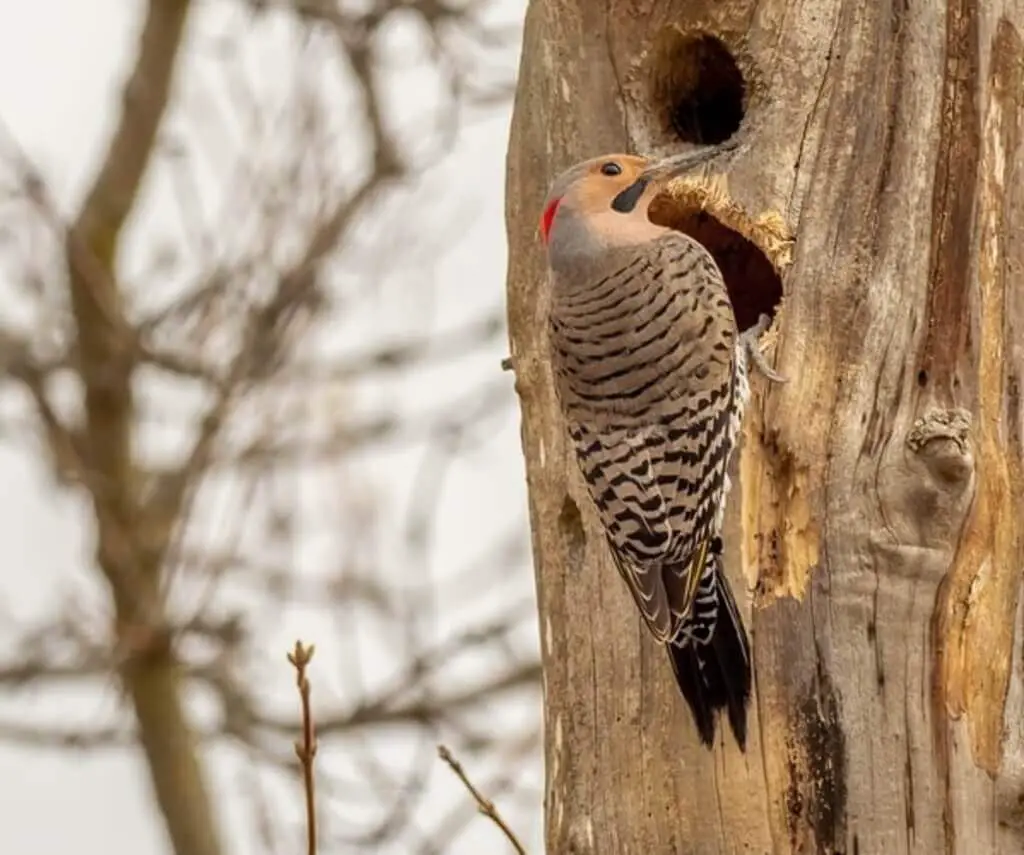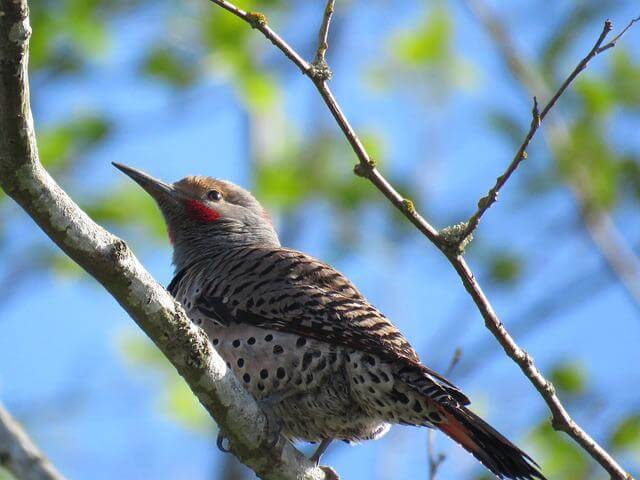Woodpeckers are a ubiquitous bird in the Pacific Northwest, and they can be seen in most forests and woodlands. There are 11 different woodpecker species found in the Pacific Northwest.
In this article, we will examine the woodpeckers of the Pacific Northwest, with pictures, photo identification, and details of each, as well as locations in which they can be found.
Table of Contents
Woodpeckers Of The Pacific Northwest
Hairy Woodpecker
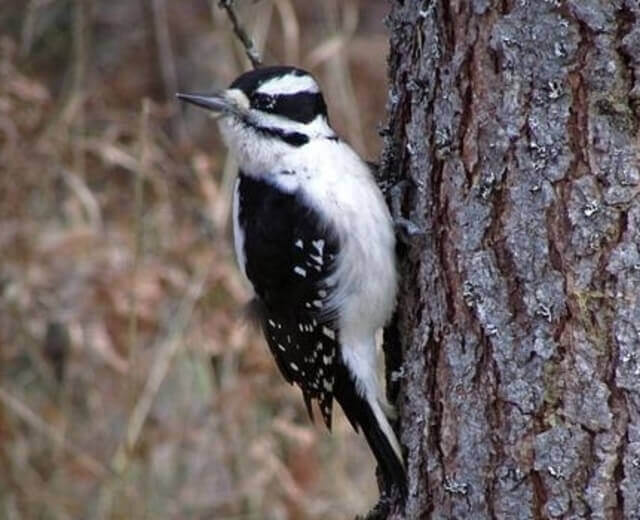
- Length: 7.1-10.2 in (18-26 cm)
- Weight: 1.4-3.4 oz (40-95 g)
- Wingspan: 13.0-16.1 in (33-41 cm)
- Where To Find Them: In the Pacific Northwest, they are found in Oregon, Washington, and Idaho.
- How to Attract: Hairy woodpeckers are one of the most common woodpeckers in North America. They are easily attracted to suet feeders, as well as peanut butter or bird seed. You can also provide a tree for them to nest in by creating a dead snag or installing a nesting box.
The Hairy Woodpecker is a North American bird that is found in forests and woodlands. They can be found from southwestern Canada to northern Mexico. These birds live in a variety of habitats, including coniferous forests, deciduous forests, and mixed woodlands.
They are usually found near water sources, such as rivers, lakes, and marshes. Hairy Woodpeckers eat a variety of foods, including insects, nuts, seeds, fruits, and berries.
Related Post: 7 Birds That Look Like Downy Woodpecker (Explained)
Downy Woodpecker
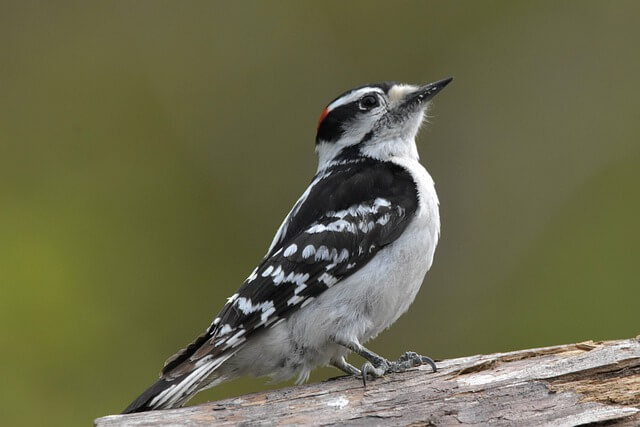
- Length: 5.5-6.7 in (14-17 cm)
- Weight: 0.7-1.0 oz (21-28 g)
- Wingspan: 9.8-11.8 in (25-30 cm)
- Where To Find Them: In the Pacific Northwest, they can be found in spots near Vancouver, Washington and Portland, Oregon. They favor areas with tall Douglas Fir trees.
- How to Attract: These birds are easily attracted to feeders filled with suet, black oil sunflower seeds, or peanuts. They will also visit bird baths to drink and bathe.
The Downy Woodpecker (Picoides pubescens) is a small woodpecker that ranges throughout most of North America. This species inhabits deciduous and mixed forests, as well as open woodlands and parks. Downy Woodpeckers forage on the bark of trees for insects, which comprise the majority of their diet.
They also consume fruits, nuts, and seeds. Downy Woodpeckers are cavity nesters and typically excavate their own nests in dead trees or rotting logs. They are monogamous birds and both parents tend to watch over their chicks.
Related Post: How to Attract Downy Woodpeckers to Your Yard? (Easy!)
Pileated Woodpecker
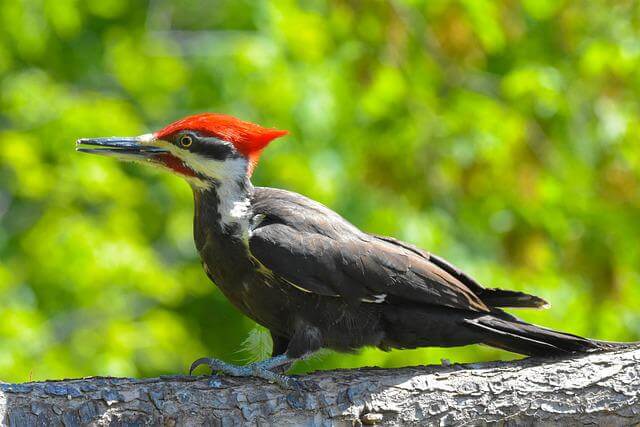
- Length: 15.8-19.3 in (40-49 cm)
- Weight: 8.8-12.3 oz (250-350 g)
- Wingspan: 26.0-29.5 in (66-75 cm)
- Where To Find Them: The Pileated Woodpecker is found in many locations in the pacific northwest. In Washington, they are found in the lowlands and mountains. In Oregon, they are found in the Coast Range, Cascade Mountains, and eastern deserts. They are also found in California, Nevada, and Idaho.
- How to Attract: Pileated woodpeckers prefer to feed on insects, so offering them a buffet of live or dead insects will help lure them to your yard. You can also put out suet feeders or bird houses designed for woodpeckers. If you provide a pileated woodpecker with a safe place to nest, they may decide to set up home in your yard. Look for a spot that is well-protected from predators and has access to plenty of insects. Dead trees or logs make ideal nesting sites for these birds.
The Pileated Woodpecker is a large North American woodpecker, the second-largest in the continent after the Ivory-billed woodpecker, that is pretty much extinct. The Pileated Woodpecker’s habitat includes hardwood forests and mixed woods across Canada, the United States, and parts of Mexico.
It prefers large tracts of forest, but can also be found in smaller woodlots. This woodpecker nests in tree cavities, but will also use abandoned nesting holes of other birds or mammals. The diet of the Pileated Woodpecker consists mainly of insects, including beetles, ants, termites, and grubs.
Related Post: How to Attract Pileated Woodpeckers to your Yard (Fast)
Northern Flicker
- Length: 11.0-12.2 in (28-31 cm)
- Weight: 3.9-5.6 oz (110-160 g)
- Wingspan: 16.5-20.1 in (42-51 cm)
- Where To Find Them: Northern Flickers can be found in a variety of locations in the Pacific Northwest, including but not limited to: Oregon, Washington, Idaho, British Columbia and Alberta.
- How to Attract: If you want to attract a Northern Flicker to your backyard, you can provide a birdbath or a small pond. A platform feeder is also a good option, as these birds like to perch while they feed. You can offer them cracked corn, black oil sunflower seeds, or peanut hearts.
The Northern Flicker is a medium-sized woodpecker found in North America, parts of Central America, and parts of South America. In the United States, they are most commonly found in the eastern and central states.
Northern Flickers live in a variety of habitats, including forests, woodlands, prairies, and even urban areas. They eat a variety of things, including insects, berries, seeds, and nuts.
Related Post: How to Attract Northern Flickers to your Backyard (Easy)
American Three-toed Woodpecker

- Length: 8.5-9.0 in (21-23 cm)
- Wingspan: 14.5-15.4 in (37-39 cm)
- Weight: 1.6-2.4 oz (45-68 g)
- Where To Find Them: In Oregon, they are most commonly found in the Cascade Mountains, but can also be found in the Coast Range and the eastern part of the state. In Washington, they are most common in the Cascade and Olympic Mountains, but can also be found in the Columbia River Gorge and along the state’s coast.
- How to Attract: In order to attract these birds to your backyard, you can install a bird feeder that includes a suet cake or peanut butter mixture, or install a dead tree or log for the birds to nest in. You can also leave dead branches on your trees, so the woodpeckers have a place to forage for insects.
The American Three-toed Woodpecker is a medium-sized black and white woodpecker found in eastern North America. They have a range that extends as far south as the southern part of Canada and as westward as Texas.
They inhabit deciduous forests and woodlands, as well as open areas with scattered trees. The diet of the American Three-toed Woodpecker consists mainly of insects, but they also eat fruit, nuts, and seeds.
Related Post: 9 Birds That Can Walk Down A Tree (Must-See!)
Black-backed Woodpecker
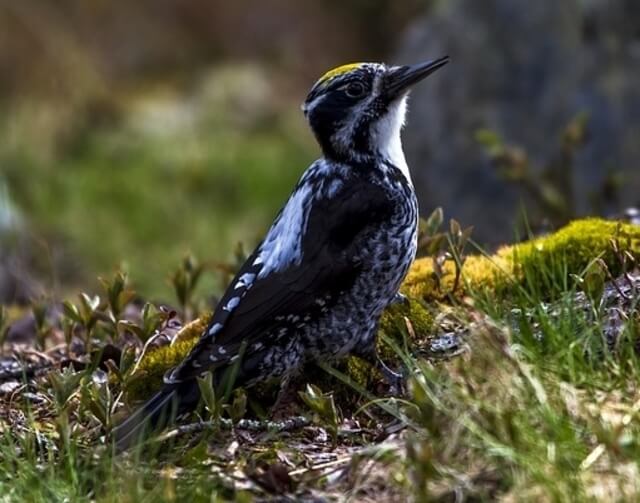
- Length: 9.1 in (23 cm)
- Weight: 2.1-3.1 oz (61-88 g)
- Wingspan: 15.8-16.5 in (40-42 cm)
- Where To Find Them: In the Pacific Northwest, they are found in the Cascade Range and along the coast from southern British Columbia to central California.
- How to Attract: These birds are attracted to dead trees and other rotting logs, where they search for insects to eat. If you want to attract these birds to your yard, you can provide them with a dead tree or log to feed on. You can also put up a bird feeder that offers suet or other insects.
The black-backed woodpecker is a medium-sized woodpecker that ranges throughout much of North America. They inhabit coniferous and mixed forests, as well as woodlands near streams. Black-backed woodpeckers feed mainly on insects, but also consume berries and nuts.
They are able to extract food from trees by hammering their beaks into the bark. These woodpeckers are monogamous, and both parents care for the young.
Red-breasted Sapsucker

- Length: 7.9-8.7 in (20-22 cm)
- Weight: 1.9-2.2 oz (53.1-63.5 g)
- Wingspan: 14.6-16.0 in (37-40.6 cm)
- Where To Find Them: Some locations where they have been spotted include Mount Rainier National Park, Olympic National Park, and Willamette National Forest.
- How to Attract: One way to bring red-breasted sapsuckers to your yard is by installing a bird feeder. They will enjoy eating the seeds that are offered. You can also put up a suet feeder, as these birds love to eat suet. In addition, you can provide them with water by setting out a bird bath or fountain. If you have tall coniferous trees in your yard, that is where you are likely to find red-breasted sapsuckers.
The Red-breasted sapsucker is a medium-sized woodpecker found in North America. They are usually around 8 inches long and have a bright red breast and head. Their primary diet is sap from trees, but they will also eat insects, fruit, and seeds.
Red-breasted sapsuckers live in a variety of habitats, including forests, parks, and yards. They prefer to live in areas with lots of trees, but can also be found in open areas with scattered trees.
Related Post: 16 Interesting Sapsucker Facts Revealed!
White-headed Woodpecker
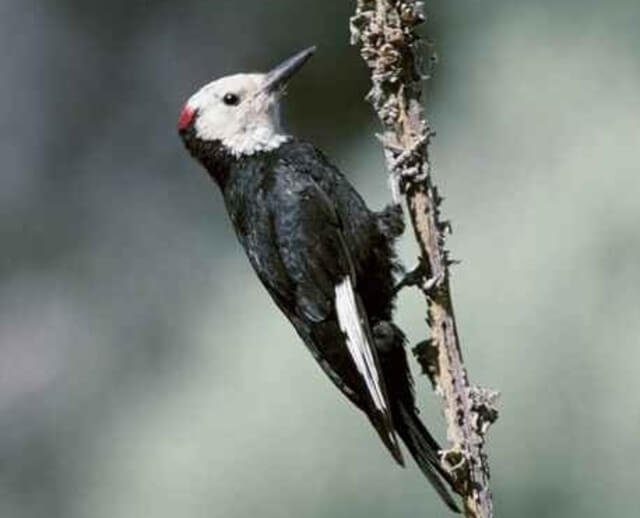
- Length: 7.9-9.1 in (20-23 cm)
- Weight: 1.9-2.3 oz (55-65 g)
- Wingspan:16.9 in (43 cm)
- Where To Find Them: In the summer they can be found in high elevations, such as the Cascade and Rocky Mountains. In the winter they can be found in lower elevations, such as the California Coast Ranges and the Sierra Nevada.
- How to Attract: First, make sure you have a good variety of trees and shrubs in your yard. The white-headed woodpecker likes to feed on insects that are found in the bark of trees. You can also provide a birdfeeder with suet or insect-rich seed to attract these bird.
The White-headed woodpecker is found in eastern North America. Its range extends from Nova Scotia west to Alberta and south to Texas. The white-headed woodpecker inhabits a variety of habitats, including deciduous and coniferous forests, open woodlands, parks, and suburbs.
In winter, it may also be found in open areas with scattered trees. This woodpecker feeds on a variety of insects, including beetles, ants, termites, and caterpillars. It also eats fruit and seeds.
Lewis’s Woodpecker
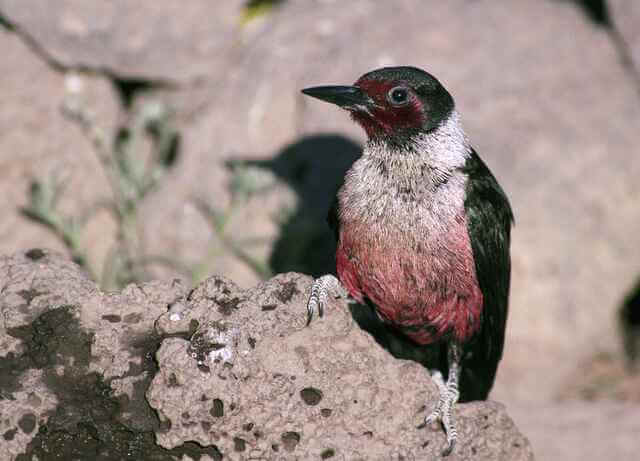
- Length: 10.0-11.0 in (25.4-28 cm)
- Weight: 3.0–5.0 oz (88–139 g)
- Wingspan: 19.3–20.5 in (49–52 cm)
- Where To Find Them: Some of the locations where they have been spotted include: Mount Rainier National Park, North Cascades National Park, and Olympic National Park.
- How to Attract: There are several things you can do to attract Lewis’s woodpeckers to your backyard. First, provide a source of food such as suet or bird seed. Second, provide a water source such as a bird bath or fountain. Third, offer shelter in the form of a nesting box or tree cavity. And fourth, create an open area with large trees for the birds to perch and forage.
The Lewis’s Woodpecker is a medium-sized woodpecker found in western North America. This bird is common in open woodlands, parks, and orchards. The Lewis’s Woodpecker is also found in suburban areas and can be seen foraging on utility poles and fences.
This woodpecker has a diet that consists mostly of insects, but it will also eat berries and seeds. The Lewis’s Woodpecker has a range that extends from southern British Columbia to central Mexico.
Red-naped Sapsucker
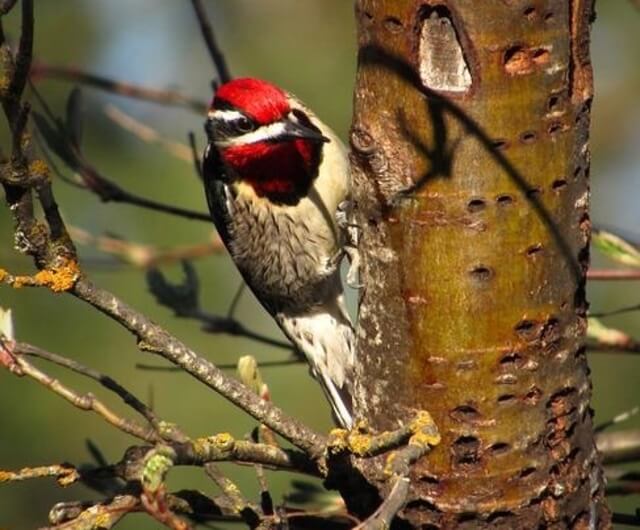
- Length: 7.9-8.7 in (20-22 cm)
- Weight: 1.9-2.2 oz (53.1-63.5 g)
- Wingspan: 14.6-16.0 in (37-40.6 cm)
- Where To Find Them: They are typically found in coniferous forests and can be seen at higher elevations in the Cascade and Rocky Mountain ranges.
- How to Attract: If you’re looking to attract red-naped sapsuckers to your backyard, there are a few things you can do to make your property more appealing to these birds. First, try planting a variety of different trees and shrubs. Red-naped sapsuckers love hardwood trees like oak and maple, as well as conifers like pine and spruce. You can also provide them with some food by putting out a feeder filled with suet or insect larvae.
The North American Red-naped Sapsucker is a medium-sized woodpecker. They are usually found in coniferous forests, but can also be found in mixed forests and deciduous forests. These birds eat insects, spiders, and other invertebrates.
They also eat fruit and seeds. Red-naped Sapsuckers breed in the springtime, and the female lays 3-5 eggs in a tree cavity. The chicks stay with the parents for about 3 weeks after they hatch.
Williamson’s Sapsucker
- Length: 7.1-8.7 in (18-22 cm)
- Weight: 1.5-1.9 oz (43-55 g)
- Wingspan: 13.4-15.8 in (34-40 cm)
- Where To Find Them: Some specific locations where they can be found include the Olympic National Park, Mt. Rainier National Park, and Crater Lake National Park.
- How to Attract: If you want to attract Williamson s Sapsuckers to your backyard, you can plant some trees that they like to eat, such as birch, maple, or oak trees. You can also put out some birdfeeders with suet or insects, and make sure there are plenty of places for the birds to perch.
Williamson’s Sapsucker is a woodpecker that is found in the western United States. It ranges from Oregon to California and east to Wyoming and Colorado.
The Williamson’s Sapsucker lives in a variety of habitats, including coniferous forests, mixed forests, and deciduous forests. This woodpecker feeds on a variety of items in its diet, including insects, sap, fruit, and nuts.
Related Post:

